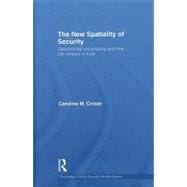
Note: Supplemental materials are not guaranteed with Rental or Used book purchases.
Purchase Benefits
What is included with this book?
| Preface | p. ix |
| Acknowledgements | p. xi |
| Introduction | p. 1 |
| Security in the noughties: from net-centric to hybrid wars | p. 3 |
| Reformulating security as a 'problematic': the role of critical security studies | p. 6 |
| A map of the work | p. 8 |
| The spatial operation of violence | p. 12 |
| Spatial orderings: bounding the conditions of possibilities of violence | p. 15 |
| Rhythm analysis: the emergence of novelty in the everyday | p. 20 |
| Difference as political: the war machine and the outside of power | p. 25 |
| Conclusions | p. 35 |
| Interlude: the (not-so-)distant roar of battle | p. 36 |
| Network-centric warfare, three-block warfare, and the new spatiality of the battlespace | p. 36 |
| Urban battlespaces: the spatial logic(s) of US military doctrine meet the experimental space(s) of the city of Baghdad | p. 43 |
| A praxiography of the battlespace | p. 50 |
| What kind of real? | p. 50 |
| A methodology for an uncertain real | p. 59 |
| Interrogating the alternate real | p. 65 |
| Conclusions | p. 67 |
| CPOF and the battlespace multiple | p. 69 |
| Locating spatial practices of violence in Baghdad | p. 69 |
| Using CPOF (1): the hardware and software architecture | p. 72 |
| Introducing multiplicity (in theory, in the TOC) | p. 77 |
| Using CPOF (2): the human dimension | p. 79 |
| Ontological singularity and multiplicity in CPOF | p. 82 |
| Addressing multiplicity in the event-ful city | p. 89 |
| The role of command in addressing multiplicity | p. 89 |
| Correlating multiplicity in CPOF through layering | p. 96 |
| Mobilizing multiplicity in CPOF through temporality | p. 98 |
| Conclusions: the experimental quality of event-fulness | p. 106 |
| From multiplicity to presence in Baghdad | p. 109 |
| Actualizing a unit in the military: the enaction of presence | p. 113 |
| Naming a 'unit-in-CPOF' | p. 118 |
| Conclusions | p. 121 |
| The mobile possibility of the 'unit-in-CPOF' | p. 123 |
| From (chrono)linear to 'track and trace' presence | p. 123 |
| The absence of the unit: exclusions, hauntings, and the limits of mobility | p. 126 |
| Conclusions | p. 134 |
| Conclusion | p. 137 |
| The political impetus of exploring space and violence | p. 139 |
| Finding a way forward for critically engaging violence | p. 141 |
| Notes | p. 142 |
| References | p. 154 |
| Index | p. 163 |
| Table of Contents provided by Ingram. All Rights Reserved. |
The New copy of this book will include any supplemental materials advertised. Please check the title of the book to determine if it should include any access cards, study guides, lab manuals, CDs, etc.
The Used, Rental and eBook copies of this book are not guaranteed to include any supplemental materials. Typically, only the book itself is included. This is true even if the title states it includes any access cards, study guides, lab manuals, CDs, etc.